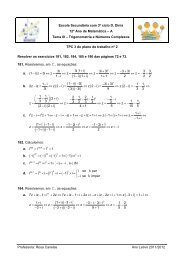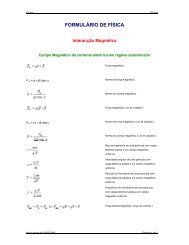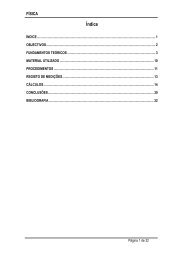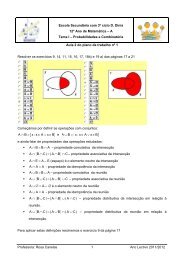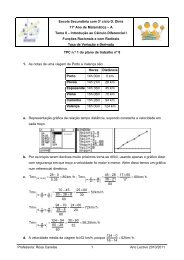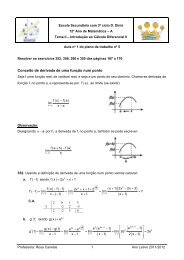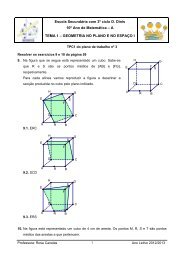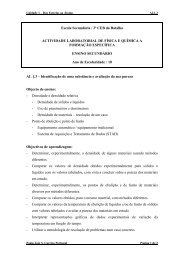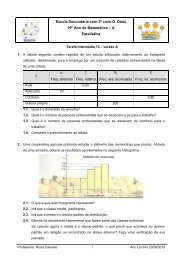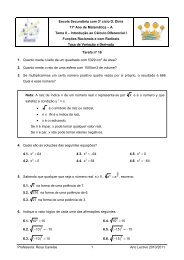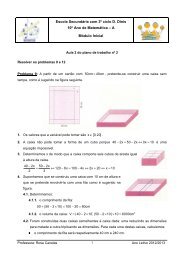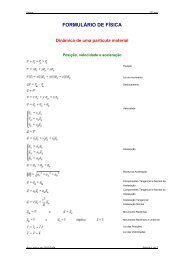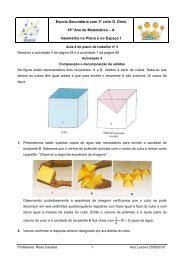Resolver as actividades 10 e 11 das páginas 43 e 44 e os ...
Resolver as actividades 10 e 11 das páginas 43 e 44 e os ...
Resolver as actividades 10 e 11 das páginas 43 e 44 e os ...
You also want an ePaper? Increase the reach of your titles
YUMPU automatically turns print PDFs into web optimized ePapers that Google loves.
ESCOLA SECUNDÁRIA COM 3º CICLO D. DINIS<br />
12º ANO DE ESCOLARIDADE DE MATEMÁTICA – A<br />
Tema II – Introdução ao Cálculo Diferencial II<br />
TPC 1 do plano de trabalho nº 7<br />
<strong>Resolver</strong> <strong>as</strong> <strong>actividades</strong> <strong>10</strong> e <strong>11</strong> d<strong>as</strong> págin<strong>as</strong> <strong>43</strong> e <strong>44</strong> e <strong>os</strong> exercíci<strong>os</strong> 57 a 61 d<strong>as</strong> págin<strong>as</strong> 42<br />
a <strong>44</strong>.<br />
Actividade <strong>10</strong><br />
1. No referencial em baixo estão representações gráfic<strong>as</strong> d<strong>as</strong> funções f, g e h definid<strong>as</strong> em IR +<br />
por: f(x) log2<br />
x<br />
= , g( x) = log3<br />
x e h( x) =<br />
4<br />
log x<br />
f está desenhada a vermelho, g a verde e h a azul.<br />
2. As afirmações seguintes são verdadeir<strong>as</strong>:<br />
a. log2 x = log3 x = log4<br />
x ⇔ x = 1<br />
b. log2 x < log3 x < log4<br />
x ⇔ x ∈ ] 0,1[<br />
c. log2 x > log3 x > log4<br />
x ⇔ x ∈ ] 1, +∞ [<br />
y<br />
<strong>10</strong><br />
0<br />
0 5<br />
-<strong>10</strong><br />
x<br />
Actividade <strong>11</strong><br />
1. Estabelecem<strong>os</strong> a correspondência seguinte entre <strong>as</strong> expressões<br />
designatóri<strong>as</strong> e <strong>os</strong> gráfic<strong>os</strong> atendendo a que tod<strong>os</strong> <strong>os</strong> gráfic<strong>os</strong> se podem<br />
f x<br />
obter a partir do gráfico de ( ) 2<br />
translações e/ou simetri<strong>as</strong>.<br />
= log x, de domínio IR + , por meio de<br />
Função<br />
( ) = ( + )<br />
g x log x 2<br />
2<br />
Gráfico<br />
Professora: R<strong>os</strong>a Canel<strong>as</strong> 1<br />
2008-2009
( ) = ( − )<br />
h x log x<br />
2<br />
( ) =−<br />
2<br />
r x<br />
log x<br />
( ) =<br />
2<br />
s x<br />
log x<br />
( ) =<br />
2 ( )<br />
m x log x<br />
2.<br />
Função Domínio Contradomínio Zer<strong>os</strong> Equação da <strong>as</strong>símptota<br />
( ) =<br />
2 ( + ) D ] 2, [<br />
g x log x 2<br />
( ) ( )<br />
2<br />
= − +∞ D' IR<br />
h x = log − x D= IR − D' IR<br />
( ) 2<br />
r x<br />
=− log x D= IR + D' IR<br />
( ) 2<br />
s x<br />
= log x D= IR + D' IR +<br />
( ) =<br />
2 ( ) D IR\ { 0}<br />
m x log x<br />
= D' IR<br />
= ( )<br />
log x + 2 = 0 ⇔<br />
2<br />
x+ 2= 1⇔ x = −1<br />
= ( )<br />
=<br />
2<br />
=<br />
2<br />
log − x = 0 ⇔<br />
2<br />
− x = 1⇔ x = − 1<br />
− log x = 0 ⇔<br />
log2<br />
x = 0 ⇔ x = 1<br />
log x = 0 ⇔<br />
log2<br />
x = 0 ⇔ x = 1<br />
=<br />
2 ( )<br />
log x = 0 ⇔<br />
x = 1⇔<br />
x = 1∨ x = − 1<br />
x =− 2<br />
x = 0<br />
x = 0<br />
x = 0<br />
x = 0<br />
Professora: R<strong>os</strong>a Canel<strong>as</strong> 2<br />
2008-2009
57.Vam<strong>os</strong> determinar a de modo que o ponto P pertença ao gráfico de f( x)<br />
= log x, sendo<br />
a<br />
a. P(3,2) será<br />
2<br />
2 loga<br />
3 a 3 a 3<br />
= ⇔ = ⇔ = porque a tem de ser p<strong>os</strong>itivo e diferente de 1.<br />
b.<br />
⎛1<br />
⎞<br />
P ⎜ , −1<br />
2<br />
⎟<br />
⎝ ⎠ será ⎛1⎞<br />
−1<br />
1 1 1<br />
− 1= loga<br />
⎜ a a 2<br />
2<br />
⎟⇔ = ⇔ = ⇔ =<br />
⎝ ⎠ 2 a 2<br />
58. Esbocem<strong>os</strong> o gráfico de f( x)<br />
⎛1<br />
⎞<br />
= ⎜<br />
2 ⎟<br />
⎝ ⎠<br />
−<br />
quadrantes ímpares, vam<strong>os</strong> desenhar o gráfico de f 1<br />
( x) log ( x)<br />
x<br />
e a partir dele por simetria em relação à bissectriz d<strong>os</strong><br />
= .<br />
Estudem<strong>os</strong> essa função:<br />
• O domínio é IR + e a função é contínua em todo o domínio.<br />
• O contradomínio é IR.<br />
log 1 = 0 e 1 é o único zero da função.<br />
• ( )<br />
1<br />
2<br />
• A função é estritamente decrescente em todo o domínio e é injectiva.<br />
• Quando x →+∞, ( )<br />
log x →−∞ e quando x 0 +<br />
1<br />
2<br />
1<br />
2<br />
→ , log ( )<br />
1<br />
2<br />
x →+∞<br />
• O gráfico intersecta o eixo d<strong>as</strong> abciss<strong>as</strong> no ponto de abcissa 1 e admite a recta de<br />
equação x = 0 como <strong>as</strong>símptota vertical. Não tem outr<strong>as</strong> <strong>as</strong>símptot<strong>as</strong> nem verticais nem<br />
não verticais.<br />
• O gráfico tem a concavidade voltada para cima e p<strong>as</strong>sa n<strong>os</strong> pont<strong>os</strong> ( )<br />
• O decrescimento quando x →+∞ é muito lento:<br />
x→+∞<br />
( x)<br />
log1<br />
lim<br />
2<br />
−x<br />
= 0<br />
⎛<br />
1, 0 e 1 ⎞<br />
⎜ ,1<br />
2<br />
⎟<br />
⎝ ⎠ .<br />
59. Seja f a função definida por: f( x) a log2<br />
x<br />
gráfico de f intersecta o eixo Ox no ponto de abcissa 2.<br />
0 = a+ log22⇔ a = −log22⇔ a= − 1<br />
= + com a∈<br />
IR. Determinem<strong>os</strong> a sabendo que o<br />
x 1<br />
60. Sendo f( x) = ln( x)<br />
e g( x) e +<br />
a. ( )( ) ( )<br />
= , a expressão simplificada de:<br />
x+ 1 x+<br />
1<br />
( ) ( ) ( )<br />
f g x = f g x = f e = ln e = x+<br />
1<br />
1+<br />
lnx lnx<br />
b. ( )( ) ( ( )) ( )<br />
g f x = g f x = g lnx = e = e× e = e⋅x<br />
61. As expressões analític<strong>as</strong> de du<strong>as</strong> funções f e g tais que:<br />
f g x lnx são f(x) lnx<br />
2<br />
a. ( )( ) =<br />
1<br />
=<br />
2 − lnx<br />
2<br />
= e g( x) = x<br />
1<br />
2 x<br />
b. ( f g)( x)<br />
são f ( x ) = e g( x)<br />
−<br />
= lnx<br />
Professora: R<strong>os</strong>a Canel<strong>as</strong> 3<br />
2008-2009




